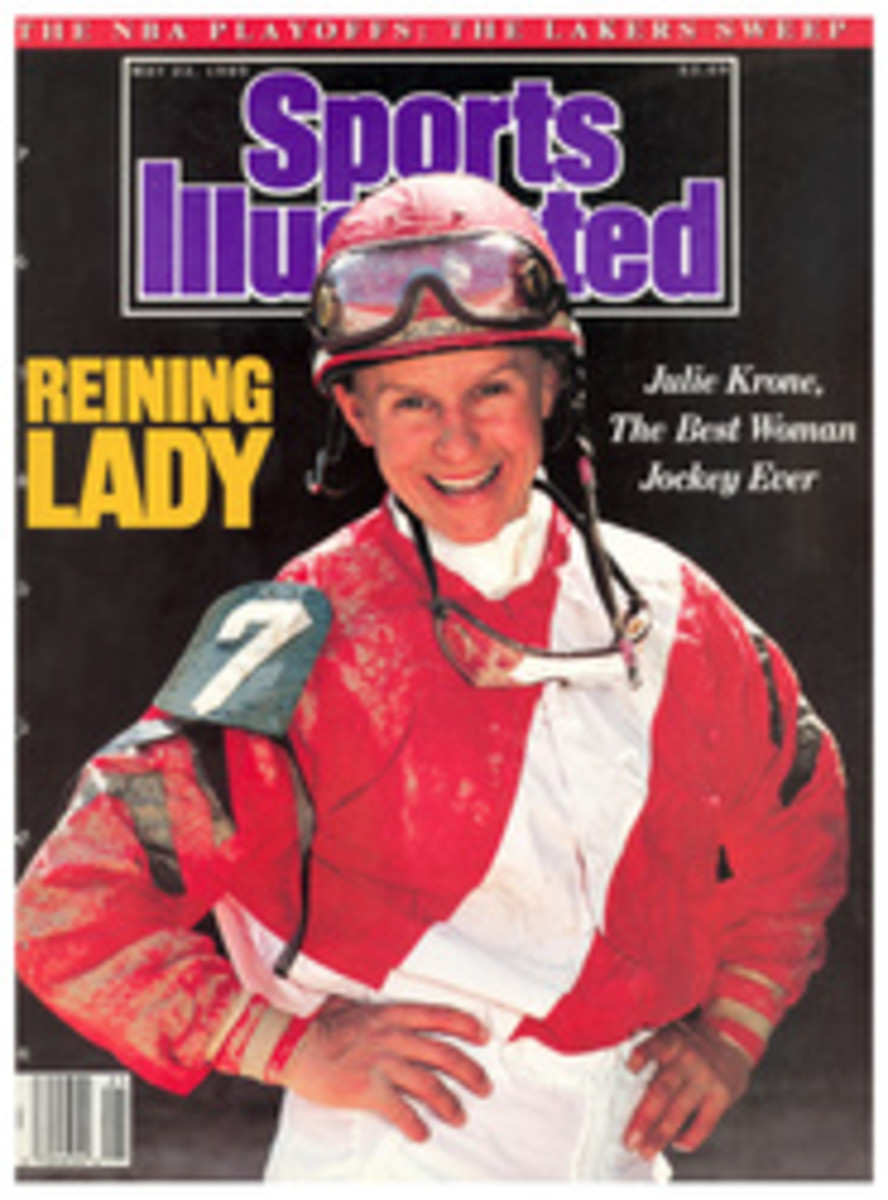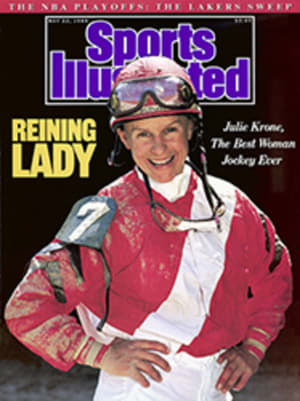
THE WHEELS OF FORTUNE
If you could get past the name, the Tour de Trump, without losing your lunch, and if you could somehow divorce the sporting event from the excess baggage that went with it—the Trump Princess, the Trump Plaza Hotel and Casino, the chest-Trumping cameos of King Donald himself, whose ideas for improving the Tour de Trump included adding a few laps around the White House and continuing the race to Los Angeles via Detroit, Chicago and San Francisco—what you had was a pretty nice bicycle race.
Not exactly a "legendary race in its first year," as Donald J. Trump crowed to an interviewer last Saturday in Baltimore, after the ninth leg of this 10-stage, 825-mile road race, which started May 5 in Albany, N.Y., and ended on Sunday on the boardwalk in Atlantic City. But it was a safe, wonderfully organized, competitive event with a great future, if it doesn't get mucked up by a certain billionaire's vainglory.
The funny thing was the communities along the route that took this race to their hearts and gave the Tour its charm—the New Paltzes (N.Y.) and Front Royals (Va.) and Allen towns (Pa.)—were as un-Trumpian as Montgomery Ward. As the 114 cyclists raced through these and dozens of other unpretentious towns beneath unrelentingly overcast skies, wide-eyed schoolchildren greeted them with drawings and welcome signs. Elderly couples, some toting American flags, waited for them at the ends of their driveways. Farmers, caught in the traffic, stood beside pickups and waved as the cyclists and the support caravan passed.
The Europeans who had come to compete or to follow the race loved it. The first six stages of the Tour passed through the Catskills, the Poconos, Pennsylvania Dutch country and the Blue Ridge Mountains and had the feeling of a European road race—rolling hills, open countryside, winding roads. Many Tour-following Americans, numbed by a lifetime of interstate highway travel, saw their homeland as if for the first time. Bands played, and townspeople, happy that this colorful festival of sport had come their way, cheered from the first finisher to the last.
The whole thing would have been positively lovable had it been christened something a little less cheeky than 'Tour Day Trump," as public address announcer Jeff Roake kept pronouncing it. Tour of what? Trump's person? His bank account? His hat size? Forget that, the racers only had 10 days.
Not that Trump's name wasn't useful in putting all this together, as he so tactfully pointed out during a prerace press conference. When asked why he hadn't named the event—which was jointly sponsored by NBC Sports, Jefferson Pilot Teleproductions and the Trump Plaza Hotel and Casino—the Tour of America, the modest Trump replied, "We could, if we wanted to have a less successful race. If we wanted to down-scale it."
Of course, he was right. Trump's association with the race not only guaranteed media coverage, but also proved a powerful attraction overseas. Two of the top three professional teams in Europe—PDM and Panasonic-Isostar, both based in the Netherlands—decided to skip the Tour of Spain, whose dates conflicted with the Tour de Trump's, to compete for the $250,000 in prize money (one-fifth of the Tour de France's purse, the richest in cycling). "One of the biggest reasons we came was that Trump was the sponsor," said PDM's team manager, Jan Gisbers. "With a man like him, we knew it would be good."
Peter Post, the manager for the Panasonic-Isostar team, echoed those sentiments, if in slightly less fluent English. "The name Trimp is goot in Europe," said Post. "Trimp's style is fantastic."
Which is another way of saying that Post never met a billionaire he didn't like. Whatever the attraction, the Tour de Trump lured an impressive first-year field, including the four most prominent American cyclists. Greg LeMond, the 1986 Tour de France winner, and Alexi Grewal, a 1984 Olympic gold medalist, joined forces in the newly formed Coors Light team, which had delusions of unseating 7-Eleven as the top U.S.-based professional team. The 7-Eleven team was led by 1988 Tour of Italy winner Andy Hampsten and by Davis Phinney, who in 1986 became the first American to win a stage in the Tour de France.
In addition to the eight professional entries, there were 11 amateur teams, the most colorful being a six-man squad from Holland that was sponsored by Sauna Diana, an Amsterdam brothel. "The largest in Holland," explained one team member. "Beautiful girls."
The class of the amateur field was the team from the Soviet Union, led by 23-year-old Viacheslav Ekimov, who holds 10 world records and was a 1988 Olympic gold medalist in team pursuit. Ekimov wasted no time making his presence felt, winning the first stage, from Albany to New Paltz (110 miles), in 4 hours, 35 minutes and 18 seconds, 49 seconds ahead of the pack. That stage will best be remembered for a hellishly difficult climb called Devil's Kitchen. Officially named Platte Cove Road but dubbed Devil's Kitchen for a nearby mountain hollow, the climb was a 15-degree grade in West Saugerties that ascended from 300 feet to 1,840 feet above sea level in a span of two miles. According to Tour director Don Hobbs, who drove some 25,000 miles in the process of mapping out the route, "The first time I took the NBC people to see it, we couldn't get up the road in their bus."
Some of the racers couldn't get up it on their bikes. The road was gritty from wear and wet with rain, and seven riders got off and pushed—something almost unheard of in serious cycling circles. One of those who pedaled to the top, Steven Rooks of the Netherlands, who was named King of the Mountain as the best hill climber in the 1988 Tour de France, said that Devil's Kitchen was as difficult as the hardest European climbs. (Rooks came down with a 103° fever after the fifth stage of the Tour and was one of 28 riders who did not finish.)
Stage 2, which was held on Sunday, May 7, began in Trump's hometown of New York City, before yawningly vacant streets—New Yorkers, it seems, are exposed to enough of the Trump magic in their weekday lives to carry them through the weekends. Then the 123-mile route ran due west through New Jersey, over rolling hills and into a head wind, before ending in Allentown, Pa. Seventy-five miles into the leg, the single most significant attack of the Tour occurred. Four men, led by Dag Otto Lauritzen of Norway, who races for 7-Eleven, and Henk Lubberding of the Netherlands, of Panasonic-Isostar, broke away from the field and finished 3:20 ahead of the pack. Lubberding won the sprint and the stage, but Lauritzen, 32, who was a bronze medalist in the '84 Olympic road race, took the overall lead, which he would not relinquish.
In the next seven stages, as the cyclists proceeded through Pennsylvania, Virginia and Maryland, the professional teams of 7-Eleven, led by Phinney and Lauritzen, and Panasonic-Isostar, led by 27-year-old Eric Vanderaerden, utterly dominated the race. In a classic bit of cycling strategy during the leg from Gettysburg, Pa., to Winchester, Va., those two teams orchestrated a 20-man break out of a congested feed zone—a designated area where the cyclists slow down to pick up rations—and gained an incredible 6:32 on the rest of the field in the final 38 miles of the leg. Among those left behind were Ekimov and LeMond, who still has not regained his form after missing most of the last two years with an assortment of injuries. The best LeMond could manage was a third place finish in the relatively easy 68-mile circuit race in Arlington, Va.—16 monotonous laps between the United States Marine Corps War Memorial and the Pentagon. He eventually finished the Tour a disappointing 27th. Now even LeMond's most ardent supporters must wonder if, at 27, he can ever make it back to the top.
With two stages left, after nearly 30 hours of racing, Vanderaerden was in third place, trailing front-runner Lauritzen by 1:10 and Lubberding by :28. He cut 20 seconds off that by finishing second—by one inch—to Phinney in the Baltimore criterium, a 30-lap no-brainer that was decided by a pack sprint in the final 500 yards. "One criterium in a stage race is O.K.," said Post, who refused to allow Vanderaerden to take a tour of Trump's yacht, the 282-foot Trump Princess, after the race, so that he could rest for Sunday's individual time trial. "Two is too much. This Trimp Tour should have more races like the first three or four days. They were very goot for cycle sport."
What was not very good for cycle sport was the way the race ended after it wheeled into Atlantic City on Sunday. The 24-mile time-trial course started in front of the Trump Plaza Hotel and Casino (surprise!), continued a mile down the boardwalk (watch out for the nails!), took a hard left through a slum area, passed in front of the Trump Castle (surprise again!) and took a right over the Brigantine Bridge.
From that point the course became a maze of turns through Brigantine Island. If there had truly been a million people watching this time trial, as Trump later estimated, it would have been impossible for a cyclist to go off the course without flattening five or six spectators. But because there were, oh, maybe 10,000 folks—including winos—paying attention, a number of riders lost track of the route and went astray, including, unfortunately, Vanderaerden. The Dutch star, who had beaten Lauritzen by :39 in the nine-mile time trial held four days earlier in Richmond, Va., went off the course when a motorcycle he was following took a wrong turn. Vanderaerden later said he went 300 to 400 yards before he realized something was amiss, and by the time he turned around, he hadn't a prayer of catching Lauritzen, who crossed the finish line in front of the Trump Plaza with the fourth-best time of the day—52:19.26—to win the $50,000 first prize by a comfortable 1:54 over Lubberding. Vanderaerden finished third.
None of which dampened the moment for Trump. Flushed—by what, his own presence?—the great man gushed, "We have a good chance of expanding the race. We are getting calls from every city on the East Coast, and they are willing to pay tremendous amounts of dollars to host us." He then outlined his vision: Begin the Tour in Boston, steer it down the coast, to Washington...Philadelphia...Detroit...Chicago—go west, young man!—to San Francisco, before concluding the show in L.A. "This thing has turned into a monster," said Trump.
Sounds like the very word.
PHOTO
CARL YARBROUGH
U.S. cyclist Phinney won the eighth stage, a 68-mile circuit that included the Pentagon.
ILLUSTRATION
VICTOR JUHASZ
The 825-mile Tour went through five states and ended on the boardwalk in Atlantic City.
PHOTO
CARL YARBROUGH
Rush hour in Baltimore: The outcome of this criterium was a one-second Phinney victory.
PHOTO
CARL YARBROUGH
Lauritzen pulled on the leader's pink jersey after Stage 2 and never relinquished it.

